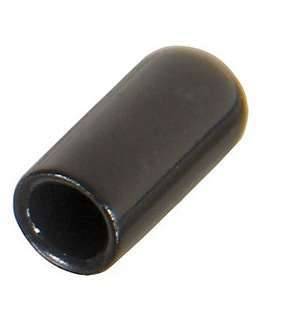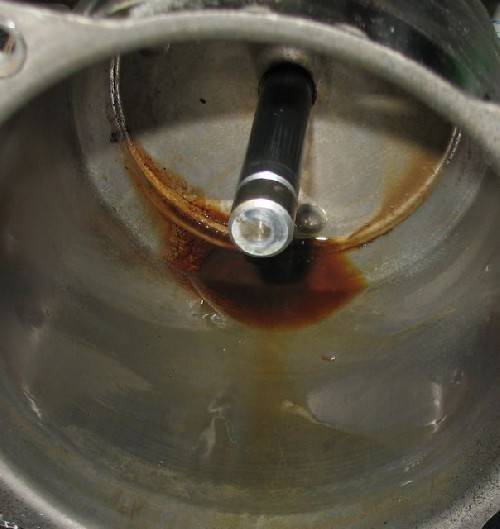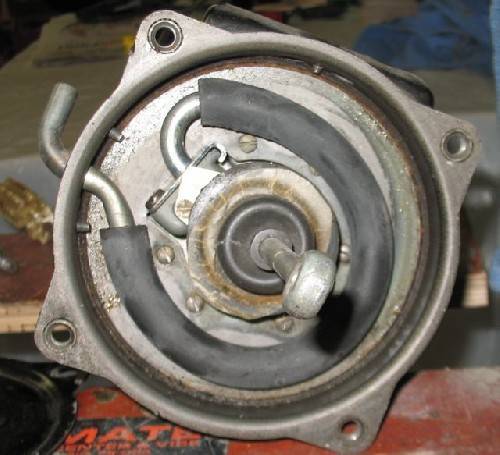|
Re: Successful Packard Hunt
|
||||
|---|---|---|---|---|
|
Forum Ambassador
|
I meant when fluid had been sucked into the vacuum side it may have gummed inside the vacuum canister.
This fluid is what I found in mine some time back -- most likely due to the relief port blocked by the gasket. If your mechanic didn't take the vacuum piston out and thoroughly clean the inside of can and the leather seal around the piston edge it can stick very nicely. Even if he cleaned once, since it is apparently still leaking the fluid may have accumulated again.
Posted on: 2012/11/4 23:33
|
|||
|
Howard
|
||||
|
||||
|
Re: Successful Packard Hunt
|
||||
|---|---|---|---|---|
|
Home away from home

|
HH,
When the MC was detached from inside the car and the cover removed, the only part accessible was the vacuum hose, so the inside of the canister has not been checked. There is, presumably, vacuum inside the cannister that could leak around the leather seal that surrounds this plate, or are you referring to the seal around the plunger itself? If there is gum in the seal around the plunger or actuator rod, then yes, I could see how that would restrict pedal movement and slow down pedal return after braking. If these sealing problems are typical of a car that has not been used regularly, is putting them to use going to be helpful, harmful, or have no effect either way. This isn't a particularly "old" BTC in terms of usage, with only 80K on the car, but that might not make any difference how much the parts have suffered from lack of use. The issue of the reservoir "cover gasket," and how it effects the operation of the compensator valve seems to be a key that could make or break the whole operation of the unit. Is there any way to remove the reservoir cover while the MC is in place, make sure the port for the compensator valve is clear of gasket material, and maybe even check the operation of the valve? I have a feeling the gasket is fine, but not so sure about the valve... and I don't want to go wrecking the gasket if its not the problem. I imaginge the gasket will stay adhered to the cover if I remove the cover.
Posted on: 2012/11/4 23:53
|
|||
|
Guy
[b]Not an Expert[/ |
||||
|
||||
|
Re: Successful Packard Hunt
|
||||
|---|---|---|---|---|
|
Forum Ambassador
|
Your compensator valve is working or you would have no pedal or brakes at all and has no connection to or with the relief port.
Referring to the photos above, The vacuum piston removes by taking the hose fitting on the side of can off. Those two screws holding the assy remove and the plate & elbow portion inside the can comes off. At the top is another screw where the air breather cover is attached so it also removes. Once those items are out of the way and pedal disconnected from rod the entire vacuum piston will slide straight out. Once vacuum section is out you can see the end of master cylinder piston rod and a large spring held by a clip inside the spring upper support. Remove the clip, support and spring and you can access the entire can. The leather around the vacuum piston can be inspected and cleaned. New lube should be applied. Might ask Ross what he recommends if it isn't mentioned in his how to. Along with Ross's write up, instructions and better pictures on removing those items than the 51-4 manual pictures are in the 55-6 service manual. As you are planning to put the car up for the winter, I'd still say the sooner the better. Would also strongly suggest you remove the BTV and have it exchanged or rebuilt by a knowledgeable rebuilder while the car is laid up. Get a couple of 3/16 or #10 vinyl screw thread protectors at the hardware store and slip them over the ends of the open tubing to keep the fluid in and dirt out. Attach file:  (8.68 KB) (8.68 KB)
Posted on: 2012/11/5 0:29
|
|||
|
Howard
|
||||
|
||||
|
Re: Successful Packard Hunt
|
||||
|---|---|---|---|---|
|
Forum Ambassador

|
Quote:
The issue of the reservoir "cover gasket," and how it effects the operation of the compensator valve seems to be a key that could make or break the whole operation of the unit. Guy, you seem to be confusing the compensator port valve with the relief port, which are two completely separate things with completely separate functions. The advice on removal of gasket material was made WRT to the relief port, which is nothing more than a passage. With the BTV in-car and the reservoir cover removed, the most you could do to the compensator port valve is tickle it. You're better off removing the unit for service on the workbench. As the 51-54 shop manual is a bit scant on details, other than overhaul, you should download the 55-56 Brakes section, which Howard cited, and study the cross-sectional diagram, which identifies all the parts by name, and the text, which describes the theory of operation. Though there are some differences in details from 52-56 (mainly in the vaccum section), the basic hydraulic system and operation is the same.
Posted on: 2012/11/5 10:08
|
|||
|
||||
|
Re: Successful Packard Hunt
|
||||
|---|---|---|---|---|
|
Home away from home

|
Thanks for the link, Brian. I think I have the compensator valve and relief port (not a valve) pretty much sorted out now. I doubt very much if the relief port is blocked.
Thanks HH for the additional info on the fact that there would be no brakes (powered or not) if the compensator port valve were not working. I focused on the compensator valve because it would be the lesser of two evils, being a possibly fixable part, rather than requiring a complete rebuild. That's just me, always looking for the least invasive procedure-- I just hate replacing good parts-- and wasting good money. Now I know that the loss of fluid is almost certainly loss into the vacuum section around the seal for the (power) piston. That seal is critical in that it must actually seal against two sources of pressure, vacuum and hydraulic. Speaking of pistons, the most confusing part of this discussion for me has been to get the idea into my head that there are TWO pistons operating here (correct me if I'm wrong): The "power" piston (or rod) and the vacuum piston which gets sucked down by the vacuum in the "SHELL" (a term that I've never run across before in power brake descriptions)and pushes on the "power" piston (which could just as well be called a piston or a rod, since it doesn't contribute anything to the "power" which is all vacuum power along with some leg power. It seems some of the refinements of these terms are omitted at times, or used inconsistently, leading one to wonder what piston they're talking about and what that big round thing is, if not a "cyllinder"? (One would think that something carrying the travel of a piston would just naturally be called a cylinder, even if it looks more like a tank.) In my ideal little world, the parts would be called: Vacuum Cylinder Vacuum Pistion Actuator Rod or just Rod Just don't be calling a rod a piston or a cyllinder a shell, even if it is 1954 and power brakes are a new deal. 
Posted on: 2012/11/12 21:26
|
|||
|
Guy
[b]Not an Expert[/ |
||||
|
||||
|
Re: Successful Packard Hunt
|
||||
|---|---|---|---|---|
|
Forum Ambassador
|
You have a point about the different names. It's a bad practice and confusing to those unfamiliar in trying to relate common terms to the BTV. That unfortunately is an item which is in no way common or similar to anything conventional today.
As to the terms suggested, even those are confusing. The actuator rod to my mind is the piece that connects the vacuum piston to the brake pedal. The item that would be called a master cylinder piston in modern units is not present in a BTV. I guess it could be a rod or more precisely a ram since it does not touch the master cylinder walls and push fluid ahead of it.
Posted on: 2012/11/12 21:50
|
|||
|
Howard
|
||||
|
||||
|
Re: Successful Packard Hunt
|
||||
|---|---|---|---|---|
|
Home away from home

|
Now I'm a little confused again with the statement that the rod "does not touch the master cylinder walls and push fluid ahead of it" While it's true that the rod itself doesn't do this, the piston at the end of the rod, which includes a valve, does apply pressure to the fluid in the master cylinder, correct?
On pg 18 of the BTV section of the '54 shop manual, there is a drawing that names this exquisite little piece of engineering the "Valve Rod" So, there we've got it, I guess, as far as the name goes. As far as operation, maybe I'm off base with the rod end "pushing" fluid, but I'm still trying to learn, here. Unfortunately, I printed out the pages of the '55 manual that Brian mentioned and couldn't read the darn part labels on the illustrations. I believe '54 was the first generation of the Packard version of the BTV, and maybe of any BTV, so they were probably struggling to keep the terminology consistent, as am I. Before turning over the unit to someone and just saying "fix it" or "gimme a rebuild" I'd like to know as much as possible about what is going on inside that little sucker. To me, it's a pretty big part of automotive history. Looking through Kimes, I can find no references to the initial offering of power brakes from Packard. Kind of strange. I take it they were an off-the-shelf item from Bendix, but were they modified for different makes? And in what automobile were they first offered?
Posted on: 2012/11/12 22:31
|
|||
|
Guy
[b]Not an Expert[/ |
||||
|
||||
|
Re: Successful Packard Hunt
|
||||
|---|---|---|---|---|
|
Forum Ambassador
|
Actually the BTV was first used by Packard in 52 and could be retrofitted to 51's if the customer wanted to buy it. The principle was the same on all but the details of the vacuum side were changed in successive versions.
What they are calling the valve rod in that illustration is what I called the actuator rod and is the piece that connects the pedal to the unit. In a conventional modern master cylinder there is a true piston. As soon as the piston is moved, it passes the reservoir opening so that way out is no longer available. The fluid is trapped in front of a rubber cup or seal which rides the walls of the cylinder. Between the cylinder walls and cup, fluid is pushed ahead of the piston and out the line opening to the wheels. In the BTV you have a cylindrical chamber but not a piston in the same sense. There is no rubber cup at the end and the rod or ram never touches anywhere except the seal surrounding the shaft at the rear. As soon as the ram leaves the rear or relaxed position, a spring closes the compensator valve tightly. However, because the ram doesn't touch the walls the opening is still available and if the valve or blob of rubber should leak, fluid can exit. If that valve is closed, the fluid is trapped by the valve, shaft seal and is pressurized by the ram moving into the cylindrical chamber. Because the fluid is confined, it can only be displaced by the relatively large ram and forced out to the wheels.
Posted on: 2012/11/12 22:51
|
|||
|
Howard
|
||||
|
||||
|
Re: Successful Packard Hunt
|
||||
|---|---|---|---|---|
|
Home away from home

|
Quote:
the rod or ram never touches anywhere except the seal surrounding the shaft at the rear. As soon as the ram leaves the rear or relaxed position, a spring closes the compensator valve tightly. However, because the ram doesn't touch the walls the opening is still available and if the valve or blob of rubber should leak, fluid can exit. If that valve is closed, the fluid is trapped by the valve, shaft seal and is pressurized by the ram moving into the cylindrical chamber. Because the fluid is confined, it can only be displaced by the relatively large ram and forced out to the wheels. Is this knew term "ram" just a synonymn for the long rod connected to the brake pedal at one end, extending through the rear plate of the vacuum cylinder (the part with the vacuum connections and the hose) and thence through what I have called the "vacuum piston" and finally through the other end of the vacuum cylinder? If so, then I would just call it a "rod" until you get to the part that enters the master cylinder, where I'd say the term "ram" might work all right, since it is "ramming" the fluid, but really I'd say calling that part a "piston" seems more likely to be understood. When I get to see the captions on the drawings in the '55 manual, I think this will all be clearer to me. Was Packard Bendix's first customer for the BTV? Were the BTV units or other types of power brakes used in other vehicles? Maybe I better check Wikipedia!
Posted on: 2012/11/12 23:47
|
|||
|
Guy
[b]Not an Expert[/ |
||||
|
||||









